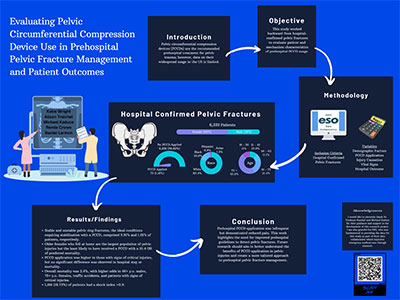ABSTRACTS
Evaluating Pelvic Circumferential Compression Device Use in Prehospital Pelvic Fracture Management and Patient OutcomesAuthor: Kobe Wright | | Associate Authors: Michael Kaduce MPS NRP, Alison Treichel MPH, Remle Crowe PhD NREMT
Introduction: Pelvic circumferential compression devices (PCCDs) are the recommended prehospital treatment for pelvic trauma; however, data on their widespread usage in the US is limited. This study worked backward from hospital-confirmed pelvic fractures to evaluate patient and mechanism characteristics of prehospital PCCD usage. Methods: A large-scale retrospective review was conducted using de-identified data from the 2022 ESO Data Collaborative. The inclusion criteria were adults with hospital-confirmed pelvic fractures transported by EMS in 2022. Key variables included patient demographics, injury location, PCCD application, vital signs, and hospital outcomes. Evaluation included logistical regression, Wilcoxon rank-sum, and, due to small sampling, post hoc analysis using adjusted residuals. Results: 6,333 patients were included, of which 4,245 (67.18%) were 60+ y.o. with 75+ y.o. females comprising 2,281 (36.01%) of all cases. 75 (1.2%) patients had prehospital PCCD application documented. PCCDs were applied less than expected in patients who were 75+ y.o., female, at home, experiencing a pubic fracture, or who fell. Conversely, they were applied more than expected in patients who were <30 y.o., male, experiencing an acetabulum or unstable pelvic ring fracture, or involved in a traumatic injury. PCCD application was higher in those with signs of critical injuries, but no significant effect was observed on hospital stay or mortality. The only significant effect detected with PCCD use was pain reduction greater than expected. The odds of a disrupted pelvic ring fracture were higher in traffic accidents (OR:1.64, CI:1.19-2.27), traumatic injuries (OR:1.84, CI:1.23-2.75), patients with a shock index (SI) >0.9 (OR:1.83, CI:1.44-2.34), and 46-60 y.o. males (OR:2.02, CI:1.33-3.04), however, 75+ y.o. females who fell were among the largest subgroups for stable (n=62) and unstable disrupted pelvic ring fractures (n=6). Overall mortality was 2.4%, with higher odds in 46+ y.o. males, 75+ y.o. females, traffic accidents, and patients with signs of critical injuries (SI>0.9, SpO2<94%, GCS<15). Conclusion: Prehospital PCCD application was infrequent but demonstrated reduced pain. This work highlights the need for improved prehospital guidelines to detect pelvic fractures. Future research should aim to understand better the benefits of PCCD application in pelvic injuries and a more tailored approach to prehospital pelvic fracture management.
|

